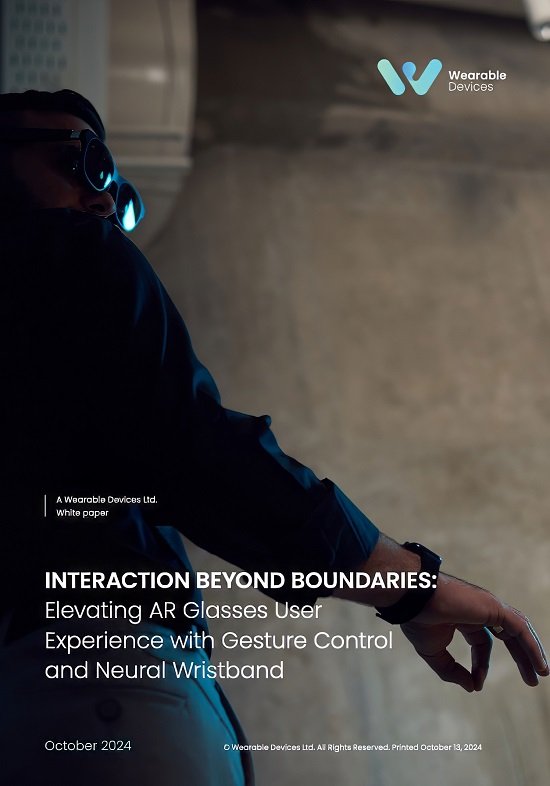Wearable Devices Unveils Foundational White Paper on the Future of Gesture Control and Neural Interfaces

Yokneam Ilit, Israel – October 22, 2024 – Wearable Devices Ltd. (the “Company” or “Wearable Devices”) (Nasdaq: WLDS, WLDSW), an award-winning pioneer in artificial intelligence (“AI”)-based wearable gesture control technology, announced the release of a landmark white paper titled, “Elevating AR Glasses User Experience with Gesture Control and Neural Wristband.” The white paper provides an in-depth and definitive analysis of emerging trends in gesture control technology, comparing camera-based solutions with wearable neural interfaces that present a clear case for the future of seamless, wrist-worn input control.
This sweeping industry and technology analysis draws on Wearable Devices’ decade of experience developing pioneering human-computer interaction (HCI) solutions, including the Company’s award-winning Mudra Band, the world’s first neural interface wristband. Wearable Devices’ thought leadership highlights not only the current landscape of gesture control for face-worn devices but also identifies critical challenges and opportunities for improving usability, comfort and interaction quality.
“Our far-reaching history in developing neural gesture-control technology uniquely positions Wearable Devices to provide this rigorous level of analysis,” said Wearable Devices Chief Executive Officer Asher Dahan. “Our Mudra technology represents a step forward in creating fluid and precise interactions with augmented reality (“AR”) glasses, eliminating the limitations of conventional input systems. This white paper offers key insights that help businesses and developers envision new ways to create user experiences where technology becomes an extension of natural human movement.”
Key Findings from the White Paper
Shift to Wearable Gesture Control for Comfort and Precision
Traditional camera-based gesture systems often require users to maintain awkward postures or suffer from fatigue (the “gorilla arm” problem). Wearable Devices’ white paper concludes that shifting input functions to wrist-worn devices like the Company’s Mudra Band (iOS) and Mudra Link (Android) creates more natural, comfortable and sustainable user experiences.
Extended Functionality with Sensor Fusion
Both the Mudra Band and Mudra Link use AI, inertial measurement units (IMU) and surface nerve conductance (SNC) sensors to deliver accurate navigation and input control through wrist movements and subtle finger gestures. The white paper emphasizes that this combination enhances precision and extends functionality beyond what camera-based systems can achieve by capturing delicate movements like pinches and fingertip pressure.
Overcoming the Limitations of Field-of-View Boundaries
Face-worn devices equipped with cameras are inherently limited by their field of view (FOV) which restricts gesture detection. Mudra Band and Mudra Link eliminate this constraint by placing sensors on the wrist, enabling gesture control even when the hands are outside the camera’s view. The white paper concludes that this ability significantly improves user interaction by allowing more fluid, uninterrupted workflows.
Bridging the Gap Between Device Types
The analysis highlights how wearable input technologies can unify different face-worn devices—such as smart glasses, monocular heads-up displays and mixed reality headsets—by offering a common, adaptable interface. Mudra Band and Mudra Link both provide discrete gestures (e.g., tap, flick, pinch) suitable for minimal displays as well as point and drag gestures optimized for immersive AR and mixed reality systems.
Reducing Device Weight and Complexity for Mass Adoption
Wearable Devices’ study concludes that placing input-related hardware on the wrist rather than the face will drive widespread adoption of AR glasses. By offloading sensors and processors to a neural wristband, manufacturers can design lighter, more comfortable glasses with extended battery life, addressing major consumer pain points identified in competing products like the Apple Vision Pro and Meta Orion.
Toward a New Standard in Human-Computer Interaction
Wearable Devices asserts in the white paper that the neural interface is not only a technical upgrade but also a philosophical shift—moving technology away from intrusive control schemes and toward seamless, intuitive interactions. This evolution supports the development of technology that responds naturally to human movement, setting a new standard in human-computer interaction.
Additional Insights and Market Context
The white paper also provides detailed comparisons between major products including Apple’s Vision Pro and Meta’s Orion glasses, exploring the trade-offs between camera-based and wearable neural gesture control wristband. The document concludes that while camera-based systems offer initial convenience, neural wearable interfaces will prevail as the gold standard as users seek more practical and comfortable input methods for all-day wear.
By publicly releasing this white paper to the AR industry, Wearable Devices reaffirms its role as a pioneer in neural gesture control and as a leader in shaping the future of wearable technology. Businesses, developers and innovators are invited to download the full white paper to explore in-depth analyses, research findings and actionable insights.


